
FourmiFood
Eggplant Parma-Sham
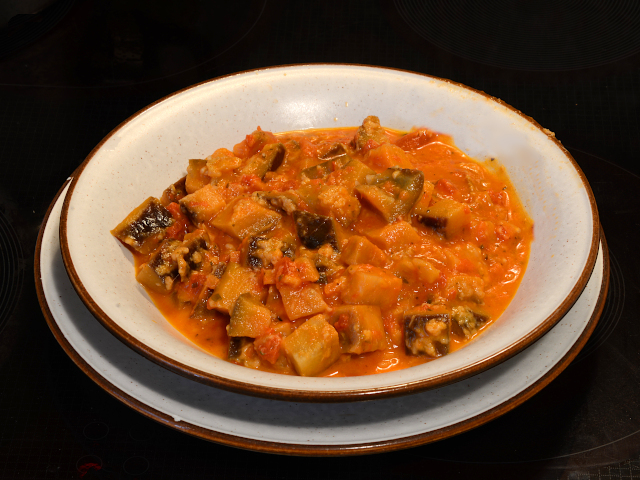

|
FourmiFoodEggplant Parma-Sham |

|
Eggplant Parmesan, also called “parmigiana di melanzane” or just “parmigiana”, is a classic Italian dish with its origins in southern Italy and Sicily. It is made from sliced eggplant (aubergine, Solanum melongena) which is traditionally fried in oil (sometimes first being dipped in beaten eggs and dredged in flour or breadcrumbs), then layered with cheese (usually a mix of mozzarella and a smaller amount of grated parmesan cheese), and a tomato sauce with customary Italian seasonings such as basil, oregano, and bay laurel leaves. Properly made, this dish is delicious, with a variety of textures and flavours to savour in every bite.
Properly made, it is also absurdly time-consuming and fussy to prepare, leaves a kitchen littered with things to clean, and is difficult to justify making unless you're trying to impress grandparents from la madrepatria. I used to buy microwaveable “heat and eat” versions of this dish which were good enough for this programmer, but sadly, they are not available where I now live, which is hundreds of times closer to Italy than where I used to enjoy them.
What to do? Well, it sounds like time to develop another improperly made FourmiFood “close enough for programmer chow” recipe, sacrificing authenticity for ease and speed of preparation, fault tolerance, and minimal clean-up in the aftermath. The result is what I call “Eggplant Parma-Sham”, which can be prepared in a fraction of the time, uses off-the-shelf ingredients, is made on the stovetop in a single pot, and is just as good re-heated as leftovers as freshly-made. On the downside, it looks like a dog's breakfast, but it tastes just fine, very close to the real thing, and has the mix of textures of the classic dish.
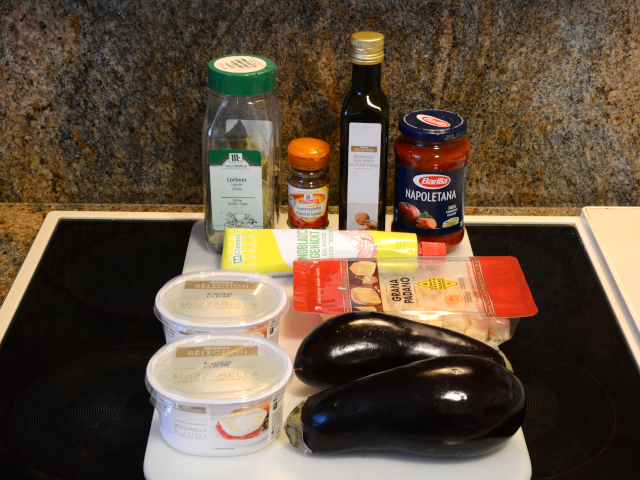
Assemble the ingredients. The quantities given make between one and two servings, depending upon how hungry you are and what you're having with it.
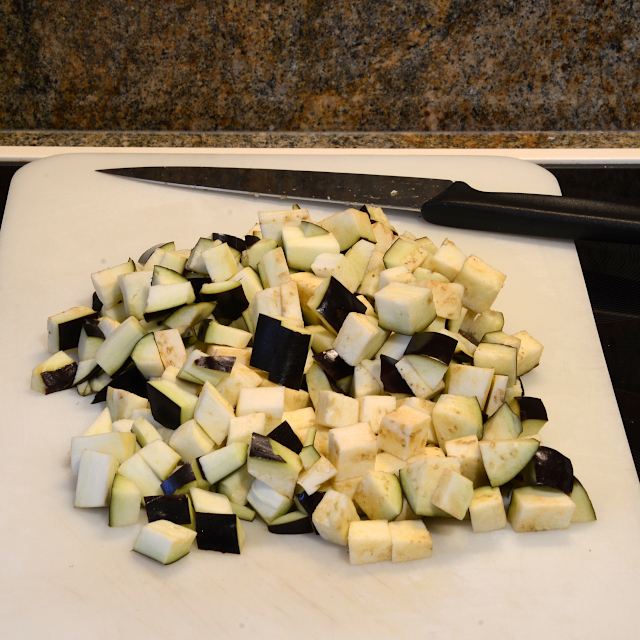 Chop the eggplant(s) into pieces around 1 centimetre on a side.
Don't worry about trying to make them uniform—the vegetables
are curvy—but try to keep the pieces bite-size or smaller so
they'll cook uniformly. Leave the skin on the eggplants; it
adds flavour and texture.
Chop the eggplant(s) into pieces around 1 centimetre on a side.
Don't worry about trying to make them uniform—the vegetables
are curvy—but try to keep the pieces bite-size or smaller so
they'll cook uniformly. Leave the skin on the eggplants; it
adds flavour and texture.
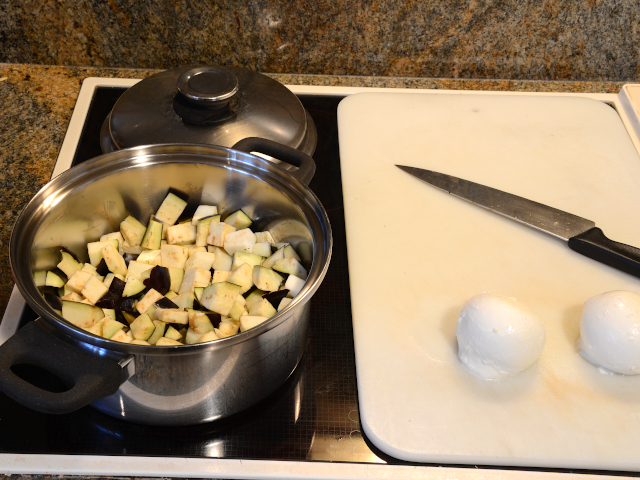 Put the vegetable oil and garlic purée in a saucepan large enough to
hold everything and add the chopped eggplant. Turn on medium-high heat
and, when it starts to sizzle, reduce heat to medium and stir to mix in
the oil and garlic and keep things from sticking. Cover the pot and
cook, stirring occasionally, until the eggplant is uniformly cooked
(usually around seven to ten minutes) at which time it will have been
reduced to about half its original volume.
Put the vegetable oil and garlic purée in a saucepan large enough to
hold everything and add the chopped eggplant. Turn on medium-high heat
and, when it starts to sizzle, reduce heat to medium and stir to mix in
the oil and garlic and keep things from sticking. Cover the pot and
cook, stirring occasionally, until the eggplant is uniformly cooked
(usually around seven to ten minutes) at which time it will have been
reduced to about half its original volume.
At the right, you can see two balls of mozzarella cheese which we've
drained and are ready to cut up and add once the eggplant is cooked.
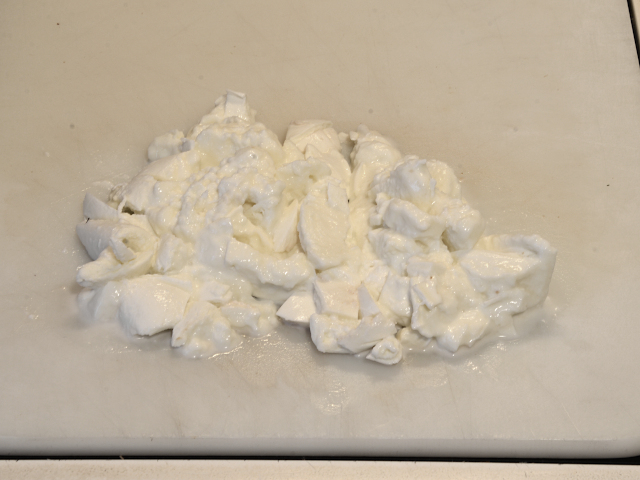 If the mozzarella cheese isn't pre-grated, chop it into small
pieces with a knife. Mozzarella comes in a variety of
textures. That shown here is buffalo mozzarella which is sold packed
in brine and is very soft. Grated mozzarella sold as a pizza topping
works well and doesn't require any work. Similarly, if the parmesan
cheese is not already grated, grate it into fine pieces. I use
a kitchen gizmo that grates chunks of parmesan directly into the
cooking pot to save time and mess.
If the mozzarella cheese isn't pre-grated, chop it into small
pieces with a knife. Mozzarella comes in a variety of
textures. That shown here is buffalo mozzarella which is sold packed
in brine and is very soft. Grated mozzarella sold as a pizza topping
works well and doesn't require any work. Similarly, if the parmesan
cheese is not already grated, grate it into fine pieces. I use
a kitchen gizmo that grates chunks of parmesan directly into the
cooking pot to save time and mess.
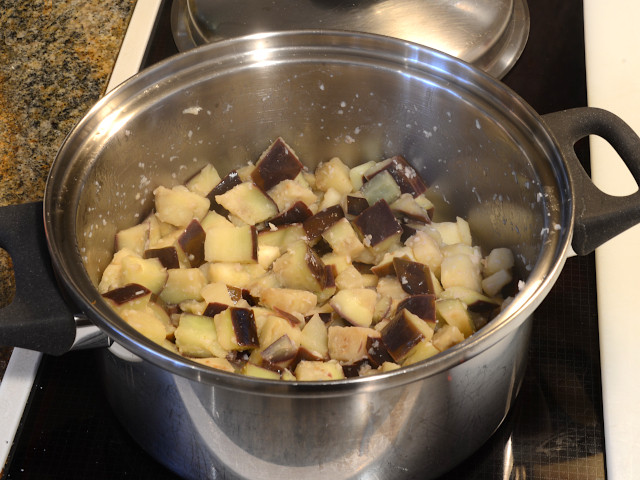 Here is the eggplant cooked down to about half its original volume.
You can adjust the cooking time depending upon the texture you
prefer, from crisp to mushy. That said, undercooked eggplant won't
take up the flavours of the sauce and cheeses.
Here is the eggplant cooked down to about half its original volume.
You can adjust the cooking time depending upon the texture you
prefer, from crisp to mushy. That said, undercooked eggplant won't
take up the flavours of the sauce and cheeses.
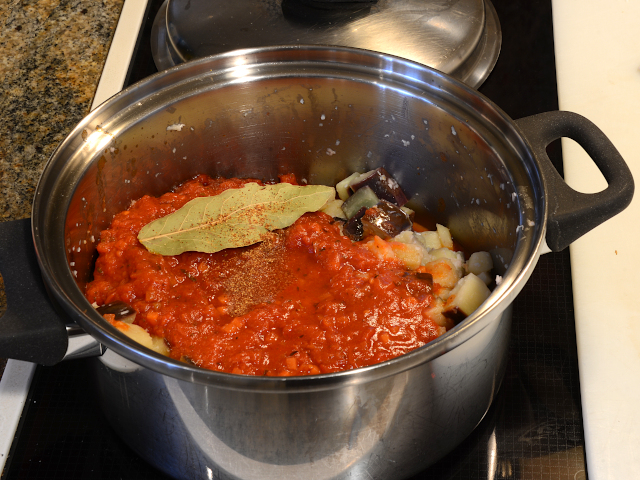 Add the prepared spaghetti sauce, bay leaf, and cayenne pepper to the
cooked eggplant. If you want to add seasonings such as
basil and oregano, sprinkle them on the sauce at this time. Stir
with a spatula to mix everything well and let it come to near boiling
on medium heat.
Add the prepared spaghetti sauce, bay leaf, and cayenne pepper to the
cooked eggplant. If you want to add seasonings such as
basil and oregano, sprinkle them on the sauce at this time. Stir
with a spatula to mix everything well and let it come to near boiling
on medium heat.
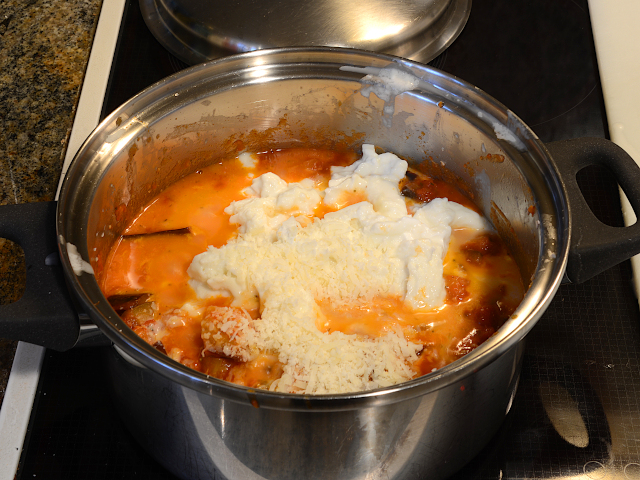 Once the mix comes up to temperature, add the chopped/grated mozzarella
and parmesan cheeses and continue to mix with a spatula until evenly
melted. Depending on the kind of mozzarella you're using, it may have
a tendency to form stringy globs and/or stick to the sides or bottom of
the pot. Scrape and stir until it melts into submission, although
there's nothing wrong with having little pieces remain to vary the
texture of the dish.
Once the mix comes up to temperature, add the chopped/grated mozzarella
and parmesan cheeses and continue to mix with a spatula until evenly
melted. Depending on the kind of mozzarella you're using, it may have
a tendency to form stringy globs and/or stick to the sides or bottom of
the pot. Scrape and stir until it melts into submission, although
there's nothing wrong with having little pieces remain to vary the
texture of the dish.
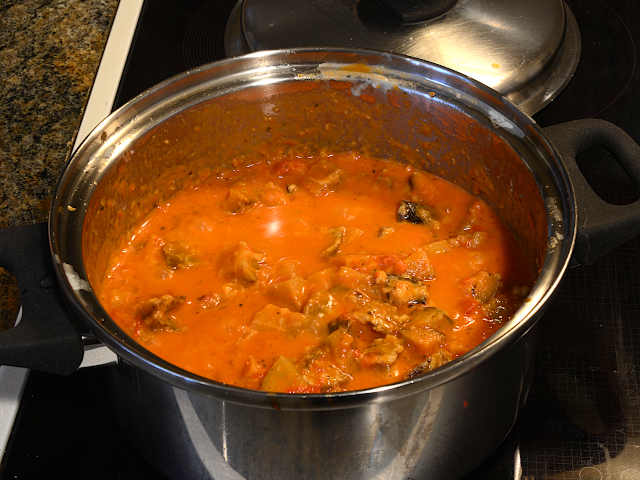 Once everything is mixed and melted, you're done—it's time to eat!
Ladle out servings into bowls and serve. Store-bought frozen garlic
bread that you can heat in the oven while you're preparing this meal
is an excellent companion.
Once everything is mixed and melted, you're done—it's time to eat!
Ladle out servings into bowls and serve. Store-bought frozen garlic
bread that you can heat in the oven while you're preparing this meal
is an excellent companion.

Here's the result, ready to dig in. It's not pretty, but it tastes fine. If you find it a bit too bland, a dash of hot sauce, well mixed in, will add some zing. I should mention that cheese and eggplant have high heat capacity, which means they retain heat for quite a while after being served from a warm pot. Be careful when you start in on the contents of a freshly-served bowl to blow on the first few spoonfuls to cool them down. Burning the roof of your mouth is painful and takes a while to heal. This stuff will do that just as well as that notorious burn hazard, pizza fresh from the oven.
If you have leftovers, pack into refrigerator boxes (I prefer serving-sized boxes that can be used individually when desired) and keep in the frigo. It's fine warmed in the microwave or, as a snack, cold.
Bon appetit!
As I noted, mozzarella cheese comes in a wide variety of forms. There isn't a huge difference in taste, at least when mixed into a dish like this, but you may find some kinds melt more easily into the mix than others.
This recipe will probably work well with other reasonably firm and bland vegetables such as zucchini or pattypan squash. I have not tried this, preferring to at least preserve a shred of authenticity and connection to the original Italian delicacy.